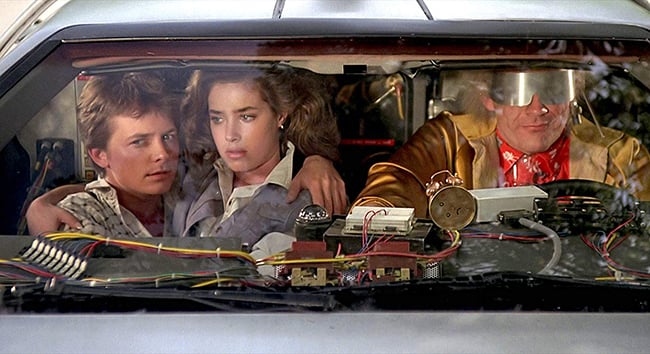
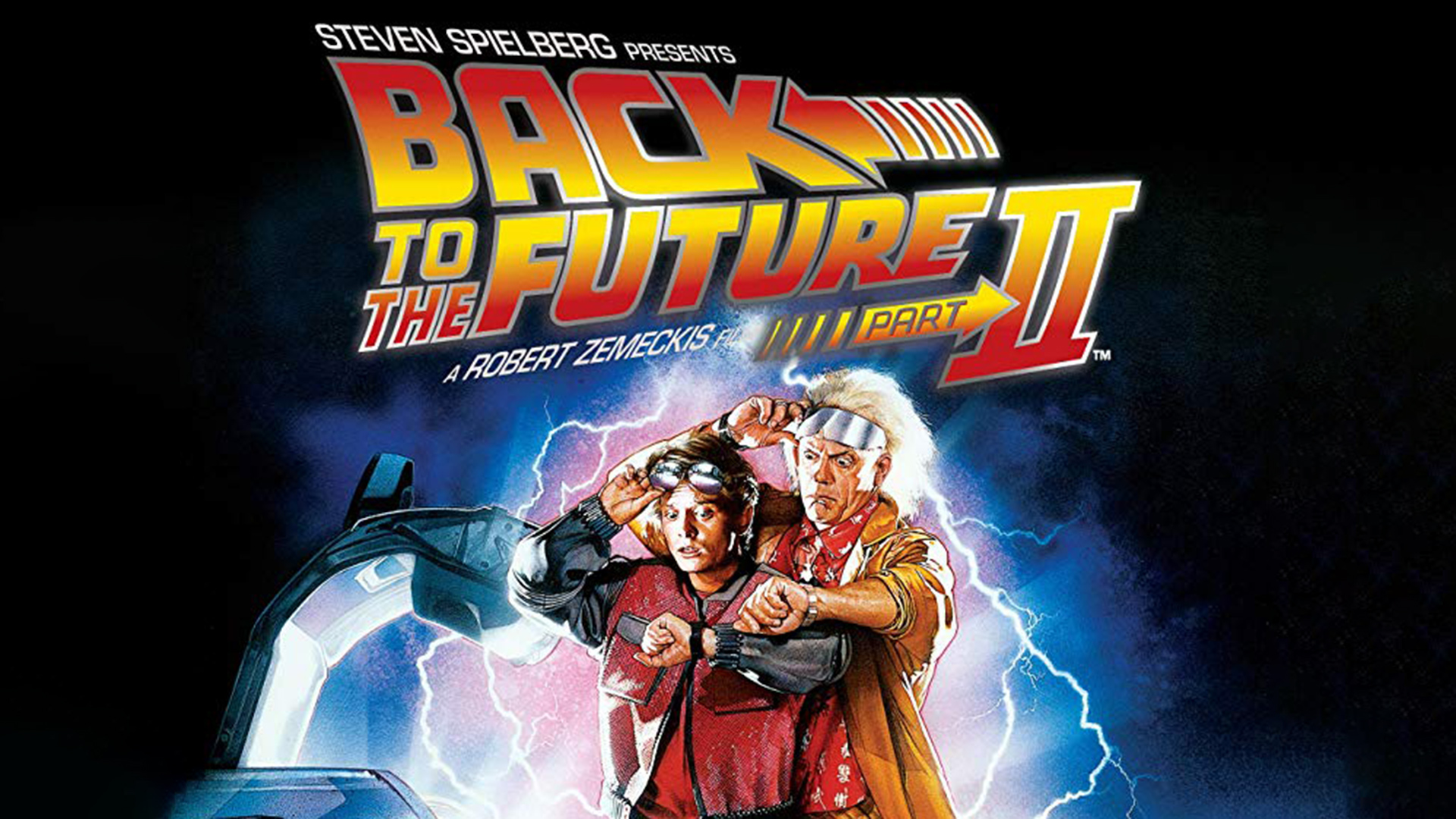
November 22nd marks the 30th anniversary of Back to the Future Part II, the middle instalment in the enduringly popular sci-fi comedy trilogy. Three decades on, the legacy of this time-hopping classic is still being felt.
For those that don’t have total recall of eighties popcorn movies, Back to the Future Part II sees teenager Marty McFly (Michael J. Fox) and his wild-eyed, crazy scientist friend Doc Brown (Christopher Lloyd) travel to the far-flung future of 2015 in order to stop Marty’s kids-to-be from getting in trouble with the law. But while they’re doing this, town bully Biff Tannen (Thomas F. Wilson) steals the time-travelling DeLorean and gives his 1955 self a book of sports statistics that will enable him to become a millionaire by placing bets. After witnessing the devastation that this has wrought on their friends and families in the “present” (1985), Marty and Doc travel back to 1955 to steal the book and restore the future.
This conceit allowed the filmmakers to revisit classic scenes from the original movie and put a second Marty into them, escaping from Biff’s goons across the overhead lighting gantry while his other self belts out Johnny B. Goode below, for example. This year’s Avengers: Endgame borrowed heavily from this idea, ironically after giving Ant-Man the line: “So Back to the Future is a bunch of bulls**t?”
Given the runaway success of the original film, a Back to the Future sequel was a no-brainer for all concerned. Director Robert Zemeckis and writer-producer Bob Gale soon found the script was growing out of control, and ended up calling Universal to tell them that not one but two sequels would be required to tell the whole story. This may not seem unusual in these days of long-form movie franchises planned out years in advance, but back in the ‘80s it was unheard of.
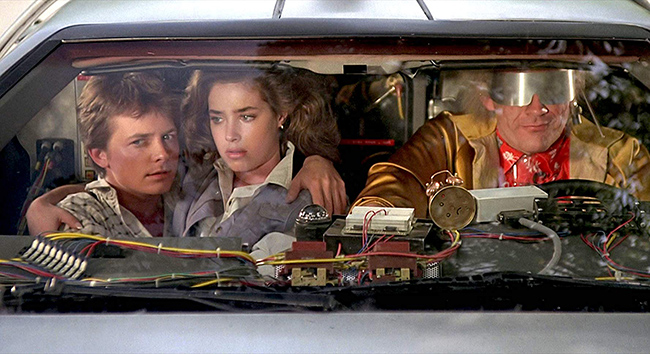 Where we're going, we don't need roads. Image: IMDB
Where we're going, we don't need roads. Image: IMDB
Back to back shooting
In a move that would be aped by Pirates of the Caribbean and Lord of the Rings, parts II and III of the Back to the Future trilogy were shot back to back. An unfortunate consequence of this was that director Robert Zemeckis had to edit Part II while shooting Part III, flying back and forth across California every day. Noting that Part II has the longest running time of the trilogy, he claims that he would most likely have cut the film tighter had his attention not been split.
One legacy the filmmakers might have regretted leaving was a new Screen Actors Guild rule about likeness rights. Crispin Glover famously declined to reprise his role as the mild-mannered George McFly, and would go on to successfully sue the production for using his likeness without permission.
Although Gale and Zemeckis reduced George’s role in the plot, making him dead in the “Biff-horrific” 1985, they used several tricks to accomplish his other scenes. These included the reuse of footage from Part I, and hanging cheap replacement actor Jeffrey Weissman upside-down throughout the 2015 scenes. Life-casts of Glover’s face taken for the ageing effects in Part I were even used to produce prosthetic make-up appliances for Weissman, so that he would resemble Glover more closely. “Oh, Crispin ain’t going to like this,” Fox reportedly remarked when he saw this, and he was right.
While the opening and closing instalments of the trilogy are relatively light on visual effects, Part II required everything from dynamic split-screens to flying cars and hoverboards. The latter employed a range of techniques, mostly involving Fox, Wilson and three other actors, plus five operators, hanging from cranes by wires. While every effort was made to hide these wires from camera – even to the extent of designing the set with a lot of camouflaging vertical lines – the film went down in VFX history as one of the first uses of digital wire removal.
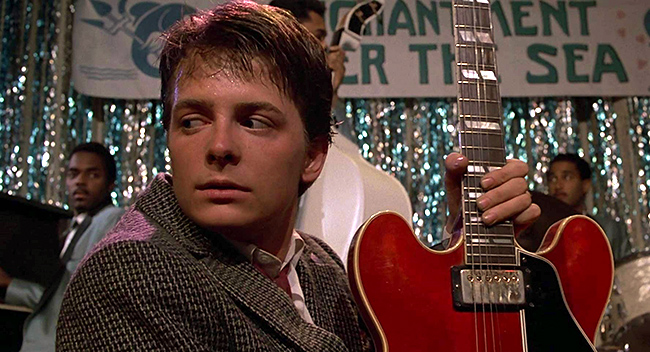 Key scenes from the first film were revisited. Image: IMDB
Key scenes from the first film were revisited. Image: IMDB
But perhaps the most complex effect in the film was a seemingly innocuous domestic dinner scene in which Marty, Marty Jr. and Marlene McFly all share a pizza. The complication was that all three roles were played by Michael J. Fox. To photograph the scene, and numerous others in which cast members portrayed old and young versions of themselves, Industrial Light & Magic developed a system called VistaGlide.
Based on the motion control rigs that had been used to shoot spaceships for Star Wars, the VistaGlide was a 35mm VistaVision camera on a computer-controlled dolly, with an integrated video playback system. For the dinner scene, Fox was first filmed as old Marty, by a human camera operator, with the VistaGlide recording the camera’s pan, tilt, focus and dolly move. Once Fox had switched to his Marty Jr. or Marlene costume, the rig could automatically repeat the camerawork, while piping Fox’s earlier dialogue to a hidden earpiece, and displaying a rough video comp for the director. Later, articulated mattes were rotoscoped, and the final composite was painstakingly produced on an optical printer.
Future predictions
It’s strange to think now that Part II’s “future” scenes are actually set in the past. When the fateful date of October 21st 2015 rolled around, many were quick to compare the film’s vision of the future to reality. But Gale always knew that he would fail if he tried to make genuine predictions: “We decided that the only way to deal with it was to make it optimistic, and have a good time with it.”
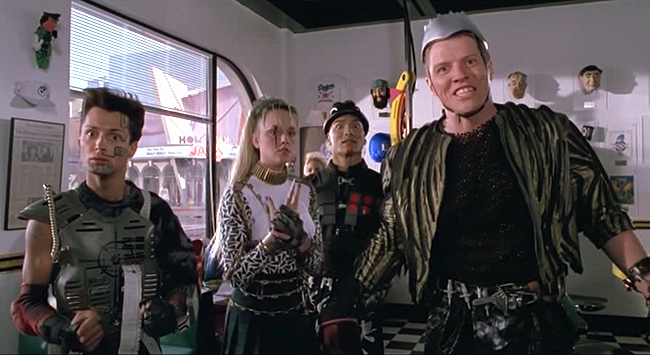 Future Biff is just as much of a bully as his ancestors
Future Biff is just as much of a bully as his ancestors
As is inevitable and right, yesterday’s vision of tomorrow tells us more about yesterday than tomorrow. “We just modified ordinary, everyday conveniences,” Gale continues. Microwave meals had begun to compete with home cooking in the ‘80s, so Gale invented a leap forward with the pizza-inflating food hydrator. Kids watched too much TV, so he envisaged a future in which this was taken to a ridiculous extreme, with Marty Jr. watching six channels simultaneously – perhaps the film’s most accurate prediction of the way we live today.
In the end, it’s not 2015 that looks ridiculous to the modern BTTF viewer, it’s the ’80s. 1985 is portrayed bleakly throughout the trilogy, with its rundown Hill Valley square, its Libyan terrorists, its graffitied high school, the materialistic fawning over shiny black Toyotas, and the Trump-like rise of Biff in Part II. Explaining why he built the time machine, Doc Brown soliloquizes: “The intent here is to gain a clear perception of humanity, where we’ve been, where we’re going, the pitfalls, the possibilities, the perils and the promise.” The filmmakers apparently believed that the ’80s were a pitfall, but the future had promise. And that optimism is still as appealing today as it was in 1989.
Tags: Production

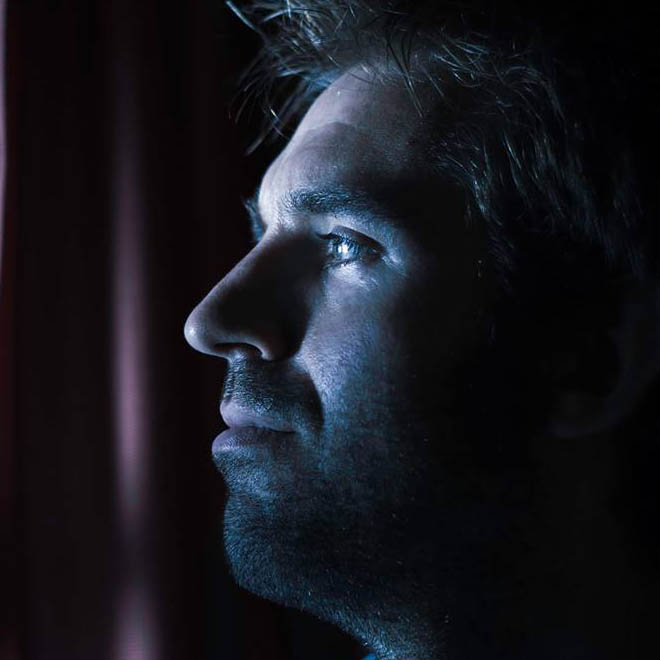
Comments